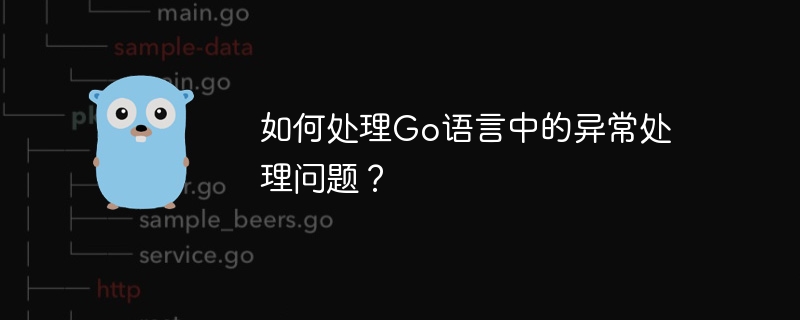

How to deal with exception handling problems in Go language?
Go language is a programming language developed by Google. It has received widespread attention and application for its simplicity, efficiency, and concurrency safety. In daily development work, exception handling is an inevitable problem. This article will introduce some methods of handling exceptions in Go language and provide specific code examples.
1. Use the built-in error handling mechanism
In the Go language, error handling is implemented by returning an error value. You can use the return value for error checking, and if an error occurs, handle it accordingly. Here is a simple example:
func divide(a, b int) (int, error) {
if b == 0 {
return 0, errors.New("除数不能为0")
}
return a / b, nil
}
func main() {
result, err := divide(10, 0)
if err != nil {
fmt.Println("发生错误:", err)
} else {
fmt.Println("结果为:", result)
}
}In the above code, the divide function receives two integers as parameters and returns an integer and an error. If the divisor is 0, a non-nil error value is returned.
2. Use the defer keyword for exception handling
The defer keyword in the Go language can perform some operations before the function returns, and can be used to handle some exceptions in a unified manner. The following is an example:
func divide(a, b int) (int, error) {
defer func() {
if err := recover(); err != nil {
fmt.Println("发生错误:", err)
}
}()
if b == 0 {
panic("除数不能为0")
}
return a / b, nil
}
func main() {
result, _ := divide(10, 0)
fmt.Println("结果为:", result)
}In the above code, the divide function uses the defer keyword to define an anonymous function that is executed before the function returns. If the divisor is 0, use the panic function to throw an exception and pass an error message. The anonymous function after the defer keyword captures this exception and handles it through the recover function.
3. Use custom error types
In addition to using the built-in error types, we can also customize some error types to better describe and handle exceptions. The following is an example:
type DivideError struct {
dividend int
divisor int
}
func (e *DivideError) Error() string {
return fmt.Sprintf("除法运算错误:%d不能被%d整除", e.dividend, e.divisor)
}
func divide(a, b int) (int, error) {
if b == 0 {
return 0, &DivideError{a, b}
}
return a / b, nil
}
func main() {
result, err := divide(10, 0)
if err != nil {
fmt.Println("发生错误:", err)
} else {
fmt.Println("结果为:", result)
}
}In the above code, we define a DivideError structure and implement error## through the Error method #interface. In the divide function, if the divisor is 0, an error value of type DivideError is returned.
The above is the detailed content of How to deal with exception handling problems in Go language?. For more information, please follow other related articles on the PHP Chinese website!
 Usage of Type keyword in Go
Usage of Type keyword in Go
 How to implement linked list in go
How to implement linked list in go
 What are the Go language programming software?
What are the Go language programming software?
 How to learn go language from 0 basics
How to learn go language from 0 basics
 What are the methods to implement operator overloading in Go language?
What are the methods to implement operator overloading in Go language?
 What are the operators in Go language?
What are the operators in Go language?
 Which is better to learn first, c language or c++?
Which is better to learn first, c language or c++?
 What to do if the embedded image is not displayed completely
What to do if the embedded image is not displayed completely




